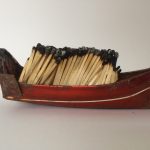Sculpture and poetry are two of the world’s oldest art forms. Despite their differences and divergent traditions, many of the most exciting developments in making and criticism consciously mix and blur the distinctions between different art forms to create a dynamic third space.
The Weight of Words features an international and intergenerational mix of contemporary artists and writers, all of whom pursue poetry through sculptural means. Ranging in tone from the humorous to the haunting, expressing everything from direct quotations to the unsayable, the works on show entangle the two art forms by compounding the three dimensional and linguistic qualities of words. Together, they reveal what can happen to languages and our experiences of them when sculptural interests in weight, materiality, form and arrangement are charged by a poetic impulse to see words take on depth and presence.
The shift between the two dimension al experience of written language and the three dimensional experience of sculpture requires a different way of looking and reading that happens physically, across space and time.
Both poetry and sculpture deal with a density of expression. Poetry in particular can change the way we think about the meaning of words or phrases, and sculpture can change the way we think about space and form. Reading, in its most conventional sense, requires the written word to be flat, linear and contiguous: one thing should follow another neatly, in a line on flat page or a screen. When poetry collides with sculpture, these conventions are disrupted, ignored or blurred: something flat becomes thickened and intensified, and words are stretched to take on new dimensions and meanings. This collision has resulted in a variety of practices and approaches, all of which occupy this exciting third space.
Some artists approach words very directly, such as Glenn Ligon’s neon quotation, Warm Broad Glow (2005). Other sculptures make use of the ambiguity of languages, including the potential for mistranslations and misunderstandings evident in Shanzhai Lyric’s Endless Garment (2018-23) and Caroline Bergvall’s Say Parsley (2004-23).
Many of the works do not feature words at all, and instead are focused on presenting the unsayable; giving meaning to experiences that cannot be adequately conveyed through words alone. Doris Salcedo’s Untitled 2008 and Issam Kourbaj’s Dark Water, Burning World 148 moons and counting… (2016) make reference to specific poems or particular events, but convey a sense of these through three dimensional rather than two dimensional means.
A newly commissioned poem by Anthony (Vahni) Capildeo will take over the black granite façade of the Henry Moore Institute. Responding directly to that material, which was quarried in Brazil and compresses millennia of mineral history, Capildeo invites the viewer to look at the surface as if they were looking down through geological time, into an aquatic ecology of naive fish and schools of Yorkshire words. Layers of language swim together across the building towards the entranceway, in a stunning design developed in collaboration with illustrator Molly Fairhurst.
Inside the galleries, new works by Tim Etchells and Joo Yeon Park will be presented. Etchells’ hanging text expands on his signature use of strong and simple means to address big ideas, here exploring the function of idioms as a form of social commentary. Park’s new work uses a refined post minimal aesthetic to confuse distinctions between form and function, between furniture and sculpture, between drawing and writing.
The Weight of Words celebrates the wealth of possibilities that this collision of art forms can generate, as two of the oldest known forms of human expression combine to produce new and powerful ways to explore what it means to read, think and write in three dimensions.
Dr Clare O’Dowd, Co-Curator of the exhibition and Research Curator at the Henry Moore Institute, says: “Following our phenomenal six month Sculpture Poetry research season of events in 2021, we realised there was so much more to say and an appetite from the public to find out more, so we felt compelled to turn this research into an engaging and thought provoking exhibition. We’re delighted to have the opportunity to continue our partnership with Nick Thurston and the University of Leeds to uncover more about this collision of art forms.”
Nick Thurston, Co-Curator of the exhibition and Associate Professor at the University of Leeds, says: “The Weight of Words asks what happens when people write and read in four dimensions, when sculpture and poetry transform one another. The parallel events programme gives us a responsive chance to discuss the consequences of that transformation. We want to expand the ways people think about sculpture and poetry, their histories of practice and reception, and art history and literary studies in turn.”
List of artists:
Anthony (Vahni) Capildeo
Bhanu Kapil
Caroline Bergvall
Doris Salcedo
Emma Hart
Glenn Ligon
Issam Kourbaj
Joo Yeon Park
Leslie Hewitt
Mark Manders
Pavel Büchler
Shanzai Lyric
Shilpa Gupta
Simone Fattal
Slavs and Tatars
Tim Etchells
Parviz Tanavoli
An extensive public programme of online events and live, in person poetry readings will accompany the exhibition. Through a series of conversations with critics, historians and writers, we will discuss why and how this entanglement of poetry and sculpture changes our understanding of art, literature and their respective histories of reception and criticism. In person poetry readings will examine the exhibition’s focus on textual language, inviting leading voices to challenge the spatial and material limits of written things. A series of film screenings in partnership with Leeds International Film Festival will showcase the role of the moving image in further pushing the boundaries between the sculptural and the poetic.
This project celebrates Leeds as a city of growing importance in the current and coming cultural landscape as it looks ahead to the impact of the planned British Library cultural centre and National Poetry Centre in the city.
Press release from the Henry Moore Institute



